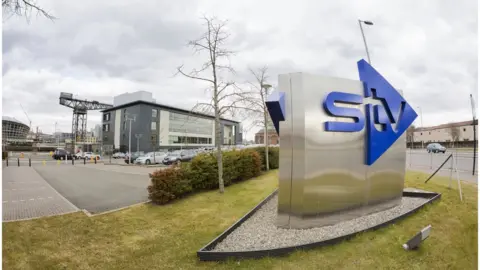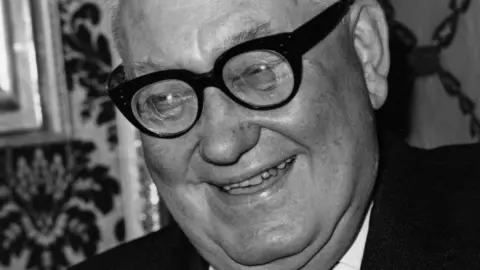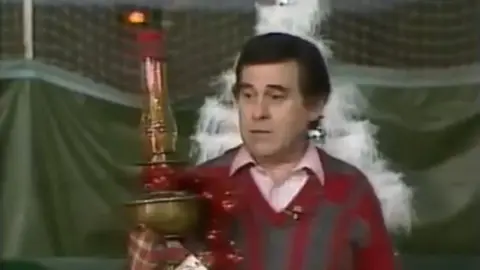STV marks 60 years in the business
 Getty Images
Getty ImagesWhen Rob Woodward became chief executive of STV Group, then called Scottish Media Group, 10 years ago, many wondered if it had a future as an independent business.
Laden with debt, the end of the company seemed almost inevitable. STV - the TV station - would survive as part of someone else's empire.
Mr Woodward leaves soon after saving the business.
But on STV's 60th birthday, it is worth reflecting on the ups and downs of a company that has touched the lives of most Scots, yet often faced serious, and sometimes unfair, criticism.
1957 -1968
On 31 August 1957, guests of honour gathered at the Theatre Royal in Glasgow's Hope Street for STV's opening night spectacular.
STV was the fifth ITV station to go on the air. While, from the start, it was always prone to present itself as a Scottish national company, although its initial reception area only stretched broadly from Ayrshire to the Tay.
Behind the business was the Canadian media mogul Roy Thomson, who owned a string of newspapers, including The Scotsman.
 Getty Images
Getty ImagesThe huge popularity of the station led to an unfortunate remark that haunted the company for a long time. Commercial television in Scotland was "a licence to print money".
For critics, this seemed to vindicate their worst fears.
STV - and the other smaller ITV companies that went on the air later - had limited access to the network as arrangements had already been hammered out by the big companies such as ATV and Granada, so they concentrated their efforts on local programmes for their own areas.
Many of STV's own programmes were loved by viewers but could be described as "cheap and cheerful" - for example the daily variety show The One O'clock Gang.
Critics felt a commercially successful company could achieve so much more creatively. Was STV printing money off the back of more ambitious programmes made by the bigger ITV companies or bought in from overseas?
A critical remark by the head of the regulatory Independent Television Authority effectively killed The One O'clock Gang. Indeed there was some surprise when STV survived a big shake up of the ITV franchises in 1968.
1968 -1986
Roy Thomson's organisation reduced its stake in STV. A fire badly damaged the Theatre Royal at the same time as the company was faced with the huge costs associated with the start of colour television. Its financial situation looked grim.
But things recovered and STV moved next door to a specially built studio complex in Cowcaddens.
By the 70s, the company had no difficulty listing impressive and ambitious productions. The 1978 adaptation of The Prime of Miss Jean Brodie is still considered to be one of the best drama productions of the time. Locally, Glen Michael's Cartoon Cavalcade followed by Scotsport, was an institution in many households.
 STV
STVThe company was re-awarded its franchise in 1980, though in some quarters a feeling persisted that STV was still not achieving its creative potential.
Perhaps this was the legacy of Roy Thomson's quote. The regulator wondered why a company that was well-run, made many popular programmes and diligently fulfilled its public service obligations should still suffer from a relatively poor image in some quarters.
Through this era traditional Scottish entertainment - including the fast-moving Thingummyjig and Scotch Corner with Andy Stewart - was still a popular part of the mix, but was this a help or a hindrance?
For a new generation this presented an unfortunate tartan-clad, kailyard image of Scotland without the class of Sir Walter Scott.
The daily rendition of a medley of old Scottish tunes at the start of broadcasting each day - familiar to viewers since 1957 but now an anachronism - perhaps added to this impression.
1986-2001
The arrival of Gus Macdonald as director of programmes (later a Labour peer) signalled far-reaching changes. Tartan-clad entertainment was out, news and current affairs was greatly strengthened and more effort than ever before was put into network programmes.
Taggart, already running, was nurtured into a massive hit. Network entertainment shows , such as game shows Wheel of Fortune and Win, Lose or Draw were popular nationally and had no sign of a tartan cringe.
The overall quality of the service and esteem in which the company was now held meant nobody bid against STV in the controversial ITV franchise auction of 1991 - it secured its right to broadcast for just £2,000 a year and made a big commitment to a wide range of local productions in return.
The on-screen changes of the late 80s were so fundamental and far-reaching that STV seemed like a different company. Indeed the name STV was banned - on screen, it was strictly Scottish Television or Scottish for short.
The company grew significantly - buying The Herald newspaper then Grampian Television in Aberdeen.
2001 -2007
A downturn in the economy and increasing competition led to STV, and other ITV regions, reducing their local output.
The end of the much-loved soap High Road seemed symbolic, while some network shows came to the end of their natural life and were not replaced.
The company sold The Herald, but was still heavily indebted. Some wondered if ITVplc - which owned the old regional stations south of the border - would buy STV, then by 2006 an effective takeover by Ulster Television seemed imminent.
2007 - 2017
 Getty Images
Getty ImagesNew chief executive Rob Woodward refocused the company - principally around the TV station, its online business and the TV production arm that makes programmes for the ITV network and other broadcasters including the BBC. Gradually the balance sheet stabilised and became healthy.
A commercial dispute with ITV led to some network programmes being dropped.
Since its resolution, the focus in local output on the main channel has mostly been on news and current affairs.
However several hours of local programmes a week go out on the secondary channel STV2, while the production business is responsible for a wide range of major programmes from Catchphrase on the ITV network to the BBC daytime staple Antiques Road Trip.
But the biggest, and very real, achievement of recent years is perhaps the fact that STV still exists at all as an independent company - the last legacy of the original ITV system, which was a federation of competing regional companies.
Maybe the survival is no surprise. At various points over the past 60 years the company's future has been uncertain, yet each time it has fought through and won.
